Home » Hunting Dogs » Pachón Navarro – The Spanish Double-Nosed Pointer
Pachón Navarro – The Spanish Double-Nosed Pointer
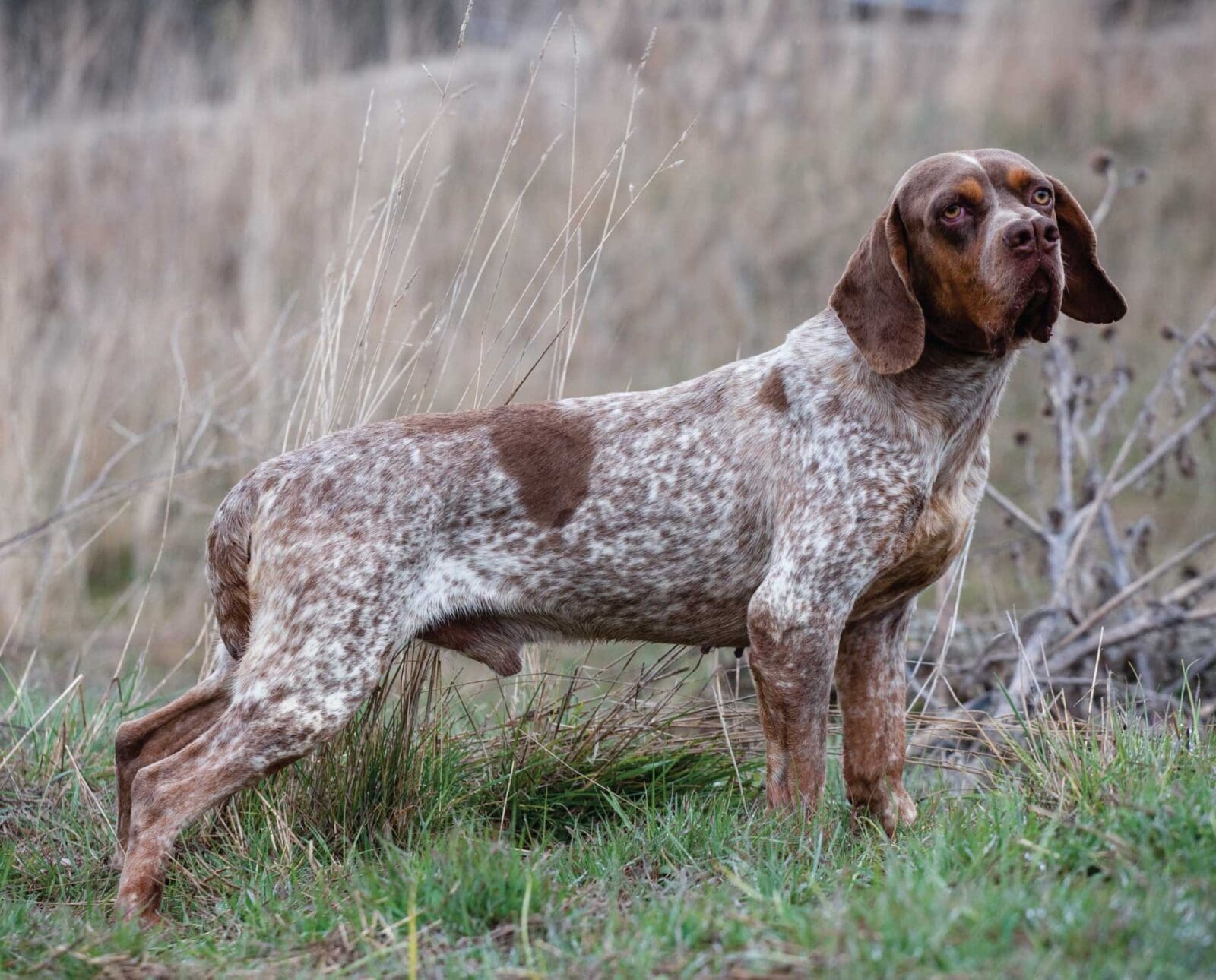
From their home base in Winnipeg, Craig Koshyk and Lisa…
The history, identification, and standards of the Spanish pointing dog breed known as the Pachón Navarro
A wonderful collection of charming stories about days spent afield with gundogs was published in 1938. The title was The Dog in Sport, and in it, author J. Wentworth Day wrote, “There were Ponto and Tanto, the two great, solemn-eyed, double-nosed Spanish pointers who lurked in a dignified way about the house, a gentle gloom upon their countenances. They were the grandchildren of the Spanish pointers owned by my great-grandfather, Robert Asplan, the little, old, dapper gentleman who wore black knee-breeches with stockings and silver-buckled shoes.”
Listen to more articles on Apple | Google | Spotify | Audible
When I first read those lines I almost said aloud, “What the heck is a double-nosed Spanish pointer?” I’d heard about Spanish pointers; they were said to be the granddaddy of the modern (English) pointer. But “double-nosed”? What was that? A nose that did double duty, air scenting and tracking? Or did double-nosed describe a physical feature? Searching the literature, I eventually found out. Freeman Lloyd, a noted American journalist, wrote in an issue of the AKC’s Gazette magazine published in the 1930s that some dogs had noses “like the double barrels of a shotgun.”
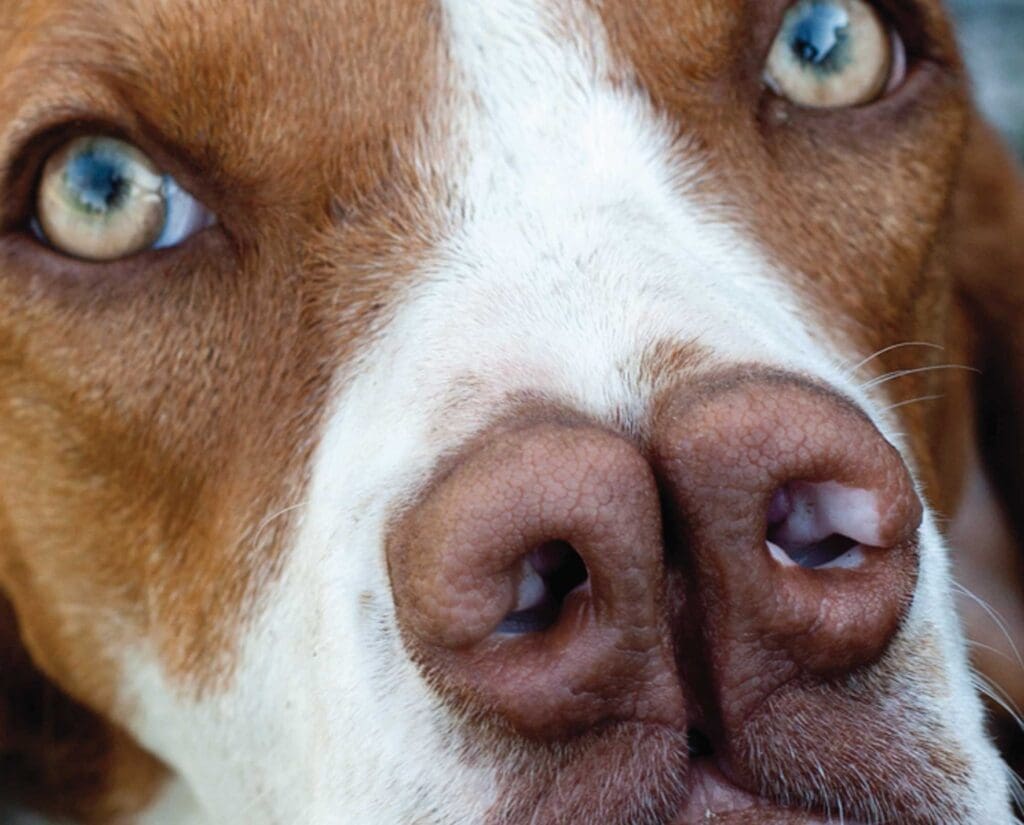
Is the Double-Nosed Pointer a Myth?
A nose like the double barrels of a shotgun? Was that even possible? I checked a few veterinary textbooks and soon learned that dogs—and people—can be born with what doctors call a bifid nose. The condition ranges from a slightly deeper than normal crease between the nostrils to a completely cleft nasal structure resulting in the double-barreled shotgun look described by Lloyd. And it turns out that Spanish pointers are not the only gundogs that can have such a nose. Even William Arkwright, author of The Pointer and His Predecessors, originally published in 1906, mentioned double-nosed gundogs from Portugal and France and wrote that he knew of a family of double-nosed Irish Red Setters.
Once I had figured out just what a double nose was and understood that dogs from various regions could have them, I was determined to find out if there were any double nosed Spanish pointers left in the world. Rereading The Dog in Sport did not give me much hope. “I think those Spanish Pointers knew that their day was done,” wrote Wentworth, “that they were the last of their race—gone with the hand-sickle and the centuries of the long September stubbles, where partridges had sat like quails.”
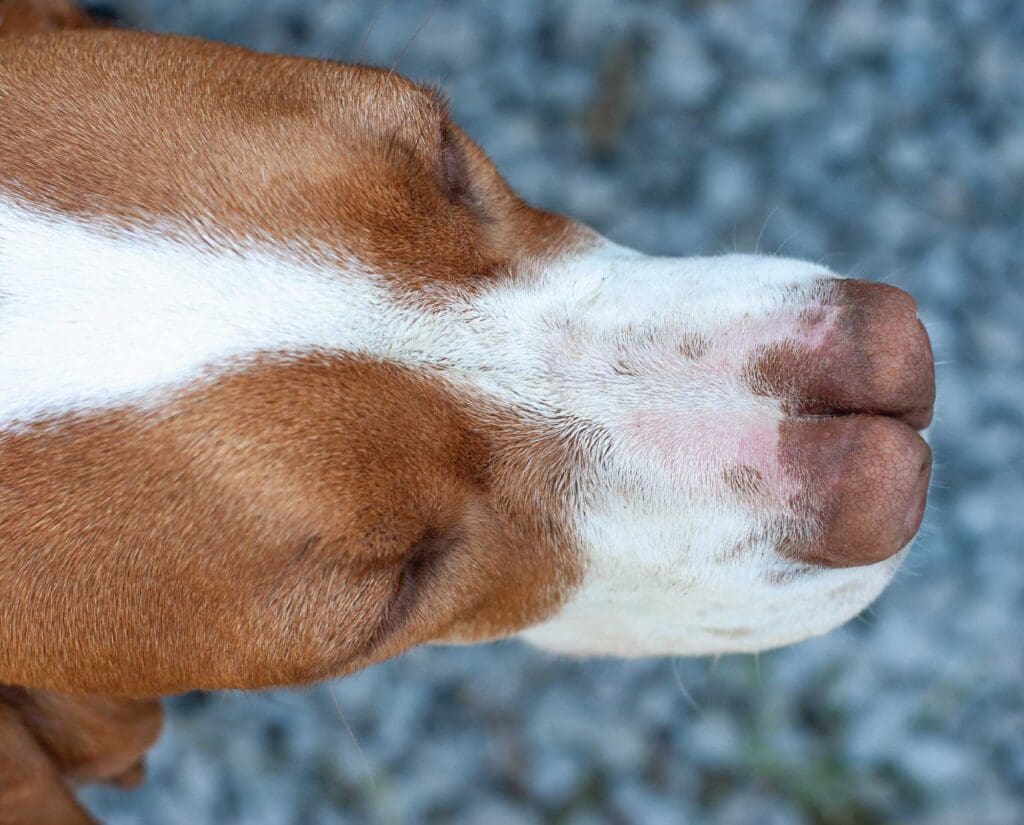
Even so, from time to time I would surf the web looking for information on “old Spanish pointers”. But I rarely turned up anything new, so I started to believe that the breed really had gone the way of the dodo bird. Then one day, more or less by accident, I came across a photograph that stopped me in my web-surfing tracks.
I had somehow stumbled onto the website for the Spanish magazine Perros de Caza, and I found myself looking at an image of a dog with an orange and white coat, amber eyes and a nose like the double barrels of a shotgun! I was stunned. This wasn’t some dusty old painting; it was a recent photograph. The dog was a modern dog. The double-nosed Spanish pointer was still alive!
Five years later, I drove with my wife, Lisa, down a narrow road to a Spanish hamlet nestled into the side of a hill near Pamplona. We were on the final leg of a journey that began with emails and phone calls and would end with a fascinating photo shoot in the foothills of the Pyrenees Mountains where the Spanish double-nosed pointer, known locally as the Pachón Navarro, is still bred.
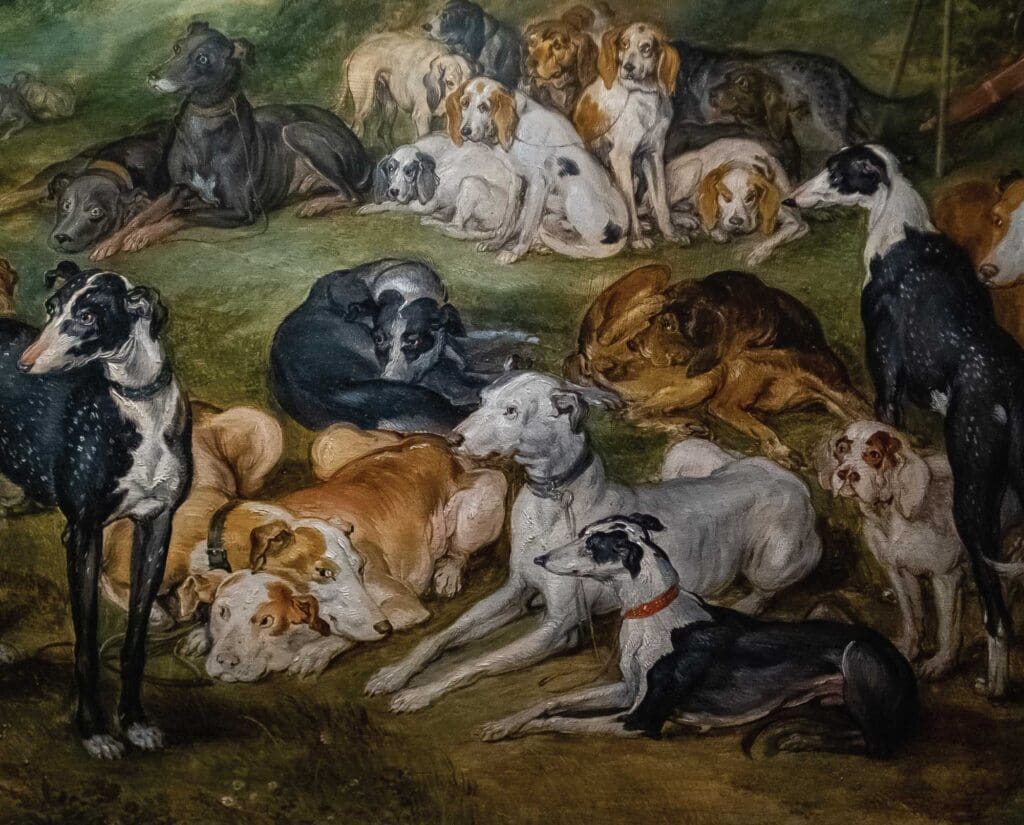
History of the Pachón Navarro
The Pachón Navarro is a fascinating breed of gundog. It is a direct link back to the pointing dogs that were first developed on both sides of the Pyrenees Mountains in the 13th Century. Until fairly recent times, there were remarkably few written references to the Pachón Navarro, but despite the lack of documentation, it is generally accepted that the breed began as a blend of the two most common kinds of dogs used for hunting in Spain during the Middle Ages—tracking dogs and indigenous mastiff breeds.
About the middle of the 15th Century, images of pointing dogs began to appear in Spain. Among the best known are a miniature falconry scene in the cathedral of Toledo and a much later painting by Velázquez of Prince of Asturias Baltasar Carlos, which features a dog that looks remarkably like the modern Pachón Navarro.
Over the centuries, Spanish hunters refined the various types of local pointing dogs and named them for the area in which they were most common. By the 1800s, dogs of the pachón type were found throughout northwestern Spain and went by a variety of names: pachón, pachón de Vitoria, pachón Español, perdiguero común, or just Navarro. But when dog shows began to be organized in Spain in the 1890s, they were all grouped under one name: Pachón Navarro.
By 1911, the Pachón Navarro gained the official recognition of the Real Sociedad Canina de España (Royal Canine Society of Spain). Thanks to influential breeders such as D. Gregorio Martínez López and several others, the breed made progress in terms of conformation and performance and continued to be bred by and for hunters until the 1950s. But when myxomatosis, a virus affecting rabbits, all but eliminated one of the main quarries of the Pachón Navarro, hunters abandoned the breed and turned to the specialist bird dogs, especially pointers and setters.
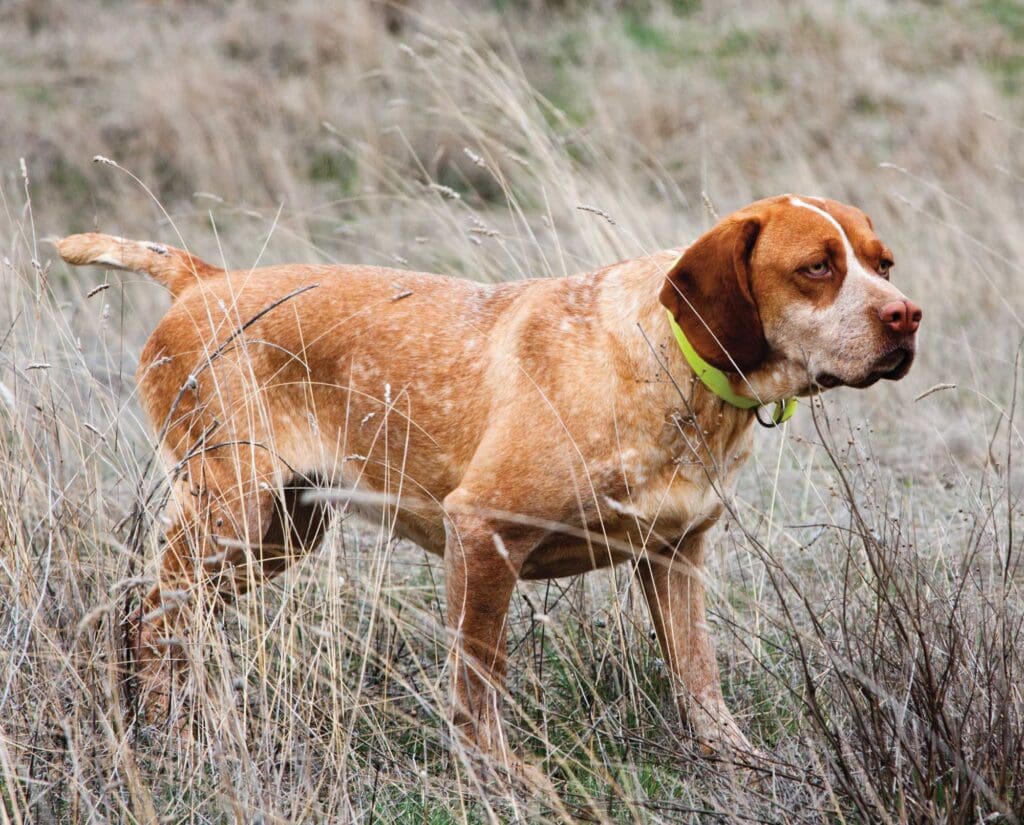
By the early 1970s, the pachón population was so low that most people believed it had gone extinct. Then, in 1978, concerned with the dire straits facing many indigenous dog breeds in Spain at the time, the Central Canine Society of Madrid created a special Commission for Spanish Breeds and appointed José Manuel Sanz Timón as overall director. In 1979 the commission asked three young veterinary students, Luis M. Arribas, Luis A. Centenera, and Carlos Contera, to locate and catalog any remaining pachónes they could find in the Narvarra, Rioja, and Alava regions as well as parts of Portugal. The project was intended to be a relatively short-term effort designed to produce a written report and census of the breed. But it ended up being much more than just a research project and anything but short-term. Today it is seen as the turning point in the history of the Pachón Navarro, since it sparked a renewed interest among Spanish hunters for their native gundog breeds.
When I finally got the opportunity to meet Dr. Carlos Contera, who had become the leader of the breed’s recuperation effort, near Guadalajara, Spain, I asked him why he became interested in the breed.
“It was great fun for a young student, but it was a lot of work,” Contera said. “People in other countries had undertaken similar surveys for horse breeds, but there was never much interest in searching for hunting dogs except for some work done in finding Spanish mastiffs. We used the same methodology to find Spanish Alans later on, but with the Pachón Navarro, I saw it was a noble cause, something that would enrich our culture. We put in an enormous amount of work without any outside help. We were criticized by many and ignored by others, but my father, uncles, and cousins all worked on the project. It took us a long time—our hair is now grey—but we’ve succeeded. The young hunters today don’t even realize that the breed was once considered to be almost extinct!”
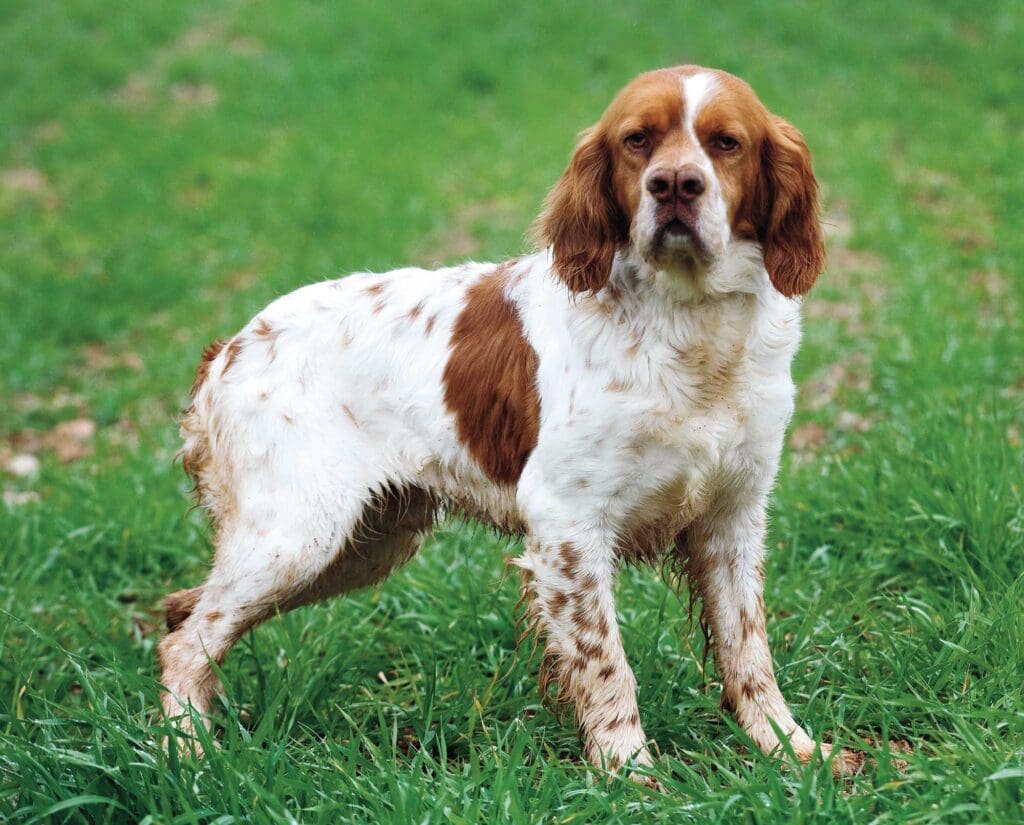
The Pachón Navarro Standards and Identification
Today the breed continues to gain ground among Spanish hunters. The number of Pachón Navarro pups whelped each year continues to climb. With a dynamic club working to gain full recognition for the breed, the future of the Pachón Navarro seems bright.
The Pachón Navarro could never be accused of looking like just another gundog. While it shares many of the features common to most continental breeds, there are some significant differences. The most obvious, of course, is the nose. All dogs have a slight crease between their nostrils, but it is usually no more than a very shallow line. Many pachónes, in contrast, have nostrils that are clearly divided by a much deeper furrow, making their noses look similar to the business end of a side-by-side shotgun. This is the famous double nose referred to in the old literature.
Anatomically, this groove is actually a cleavage in the structure of the nose itself. It is not unique to the Pachón Navarro, but when breed standards mention a split or double nose, as many do, it is always listed as a serious or disqualifying fault. The Pachón Navarro standard is the only one that allows it.
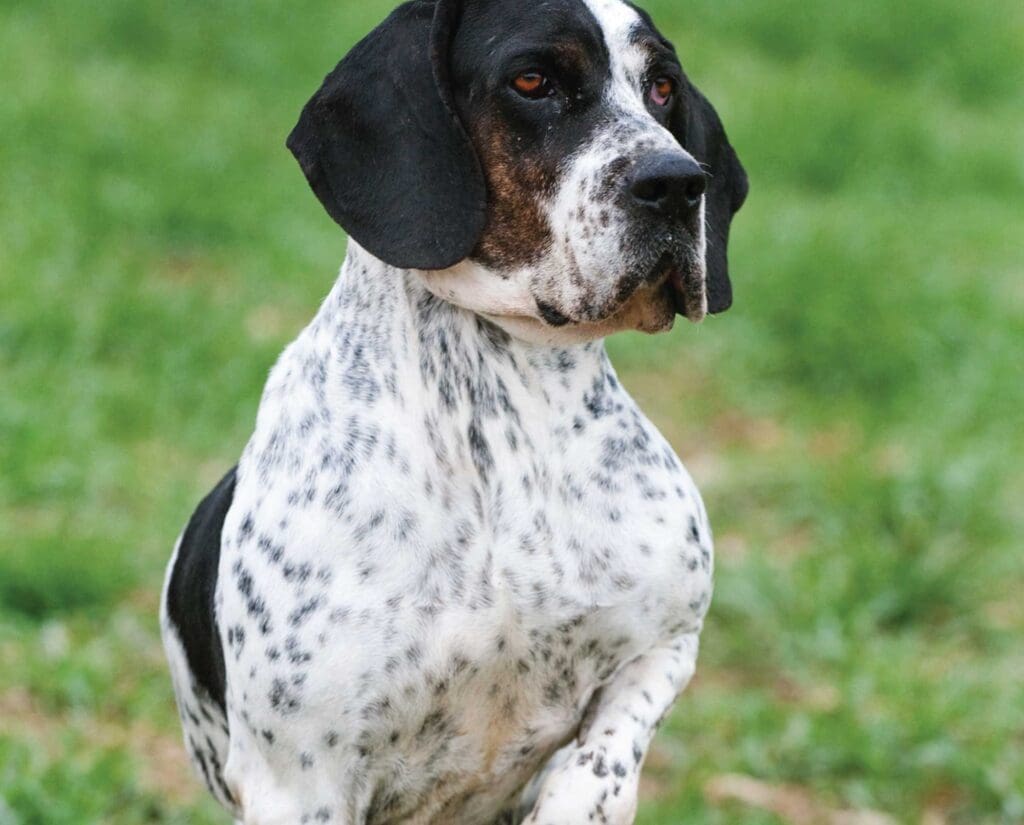
Just how did the double nose come to be viewed as a positive characteristic for the Pachón Navarro? We can only speculate. Possibly an individual with a split nose just happened to be an excellent hunter with a very fine sense of smell. Was this then seen as “proof” that a double nose was better than a regular nose?
Nowadays, of course, breeders understand that the double nose offers no advantage over a normal nose and that it is simply a cosmetic feature of the breed. Furthermore, not all pachónes have a double nose. Nor do all breeders select for it. Pachón breeders understand that by using double-nosed dogs in their lines, they run the risk of producing pups with completely cleft palates. I was told that up to 10 percent of pups are either stillborn or are put down immediately after birth since the cleft is so profound that they are incapable of breathing or nursing properly. But most pachónes have a moderate cleft and are fine. They can breathe and suckle, run and hunt just like any other dog.
The most common coat type in the breed is a short, smooth coat similar to that of other shorthaired continental breeds. A longhaired or seduño coat similar in length and texture to that of some Brittanys is also accepted. A wide variety of colors are allowed. Carlos Contera told me that the pachón is a hunting dog, and there are no bad colors for hunting dogs. The most common combinations are white and orange, white and brown, white and black, and white and liver (a darker shade of brown), with or without patches or ticking. There are also self-colored (uniform) and tri-colored coats.
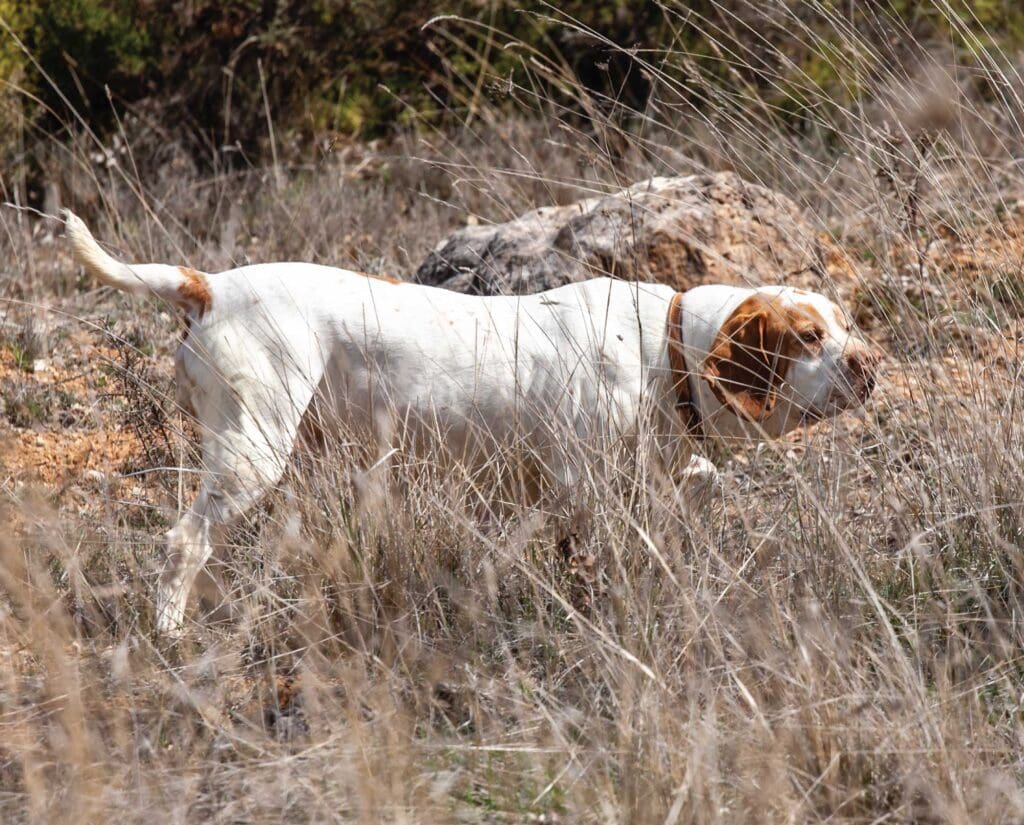
Hunting with the Pachón Navarro
Our first encounter with the Pachón Navarro was in 2001 near Pamplona. Lisa and I had traveled from France to visit pachón breeder Juan J. García Estévez, the vice president of the Círculo de Cazadores y Criadores de Pachón Navarro (Pachón Navarro Breeders and Hunt Club). When we arrived, we were welcomed warmly by Juan and his lovely wife, Carla, and by the most extraordinary-looking dogs we had ever seen. A solidly built bitch and two six-month-old pups greeted us as we stepped into the yard. All of them had noses that fit Freeman Lloyd’s description to a tee—they were like the double barrels of a shotgun!
We spent two days with Juan and Carla and learned a lot about their dogs and the program to revive the breed. On an absolutely beautiful afternoon and evening walk in the hills near their home, we watched their dogs work in the extraordinary light of the foothills of Los Pirineos, the Pyrenees, the breed’s birthplace.
I found the dogs to be exactly as advertised. They were tireless workers that kept a steady pace searching for game more or less within gun range. They mainly trotted but broke into a loping gallop for a minute or two if the conditions warranted it and dug into even the thickest cover.
It was four years later, on another trip to Spain, that we had the distinct pleasure of meeting Carlos Contera and his father, Manuel. Juan was there too. He kindly drove the three hours from his home to meet us once again. This time we saw a larger number of dogs, some with the double nose, some without. We also had the opportunity to see the longhaired version of the breed.
In the field, we followed along as the Conteras hunted quail with their dogs. My initial impressions of the breed were confirmed. All the pachónes showed a good degree of desire, hunting hard despite the thick, thorny cover. Points were fairly intense but often lasted only until the gunner was within about five meters, at which point the dog would bust into the thick, thorny cover to flush the bird.
The terrain and game they pursued were exactly as described in many classic works on pointing dogs. In fact, I am sure Carlos and Manuel could have used nets or crossbows instead of modern firearms. The dogs certainly worked close enough and were able to sniff out the tiny European quail even in the tightest cover on that hot, dry day. Studying the Pachónes Navarro and watching them work gave me a real sense of what it must have been like to hunt with pointing dogs in the 14th Century—a unique opportunity to experience the past in the present.
From their home base in Winnipeg, Craig Koshyk and Lisa Trottier travel all over hunting everything from snipe, woodcock to grouse, geese and pheasants. In the 1990s they began a quest to research, photograph, and hunt over all of the pointing breeds from continental Europe and published Pointing Dogs, Volume One: The Continentals. The follow-up to the first volume, Pointing Dogs, Volume Two, the British and Irish Breeds, is slated for release in 2020.




Great article! I’ve read many nebulous references to “Spanish Pointers” being the origin of pointing behavior in all modern pointing breeds. Until now, I’ve never read anything that attempted to explain what a Spanish Pointer was or where it came from. Thank you!
Great article and research!
What a great opportunity to see this Basque breed. I attended the University of Barcelona for a year, and had heard talk of this field dog (friends from Logrono) but our hikes were always with Sabuesos — popular for weekend rabbit hunts. Most of our American breeds have genetic roots to the European continent, and this history is fascinating! Thank you!
Great article!
Thank you and everyone involved in shoring up a breed almost forgotten and maybe lost to us.Anyone who has ever owned the pointers and setters as working dogs would be thrilled to read your article,they simply were such enjoyable partners in our lives.Gentle but enthusiastic about the hunt.The thrill of fall always came with the first loading of the dogs to finally hunt again,months of preparation were put behind and the first week always brought me great satisfaction and some of the most excruciating leg cramps after our long day afield.But alas deer hunting and leases closed off thousands of acres once available to the public,then the young people left the farms and fire ants became a scourge in the south and spread northward.But how I almost tremble again every time I see them in my minds eye circling,scenting then locking up on point,our best ones honored the other on point.May we have these days again in heaven endless fields with creeks to cross and oranges in our game bags with two or three of our old friends searching for quail before and besides us.That would be glorious to me and dad
Well what you know, I learned something about the breed double double…Interesting read and excellent article. Would have liked to see more photos clips but okay. Thank you
Great article… my father and I bred the Bluetick Coonhound which had a “split” nose… they came from a breeder here in W.Va. named Kelly Bragg.